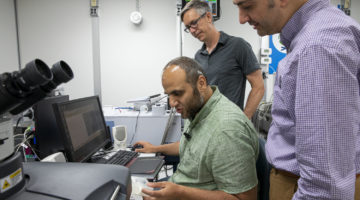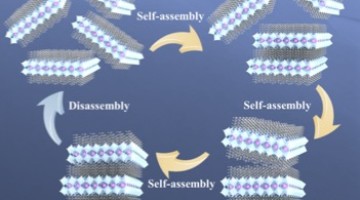A set of genes from a marine bacterium has been found to encode the biosynthesis of a promising antidepressant drug candidate. This work, which used the ALS to solve the structure of a key enzyme, could enable industrial-scale bioproduction of the drug in ways that are more efficient and sustainable than chemical synthesis. Read more »
ALS Work Using Scattering/Diffraction
These techniques make use of the patterns of light produced when x-rays are deflected by the closely spaced lattice of atoms in solids and are commonly used to determine the structures of crystals and large molecules such as proteins.
Argon: Not So Noble in Earth’s Core
Researchers demonstrated the synthesis of a thermodynamically stable compound of argon and nickel at temperatures and pressures representative of the Earth’s core. The ability of argon, a noble gas, to react with other elements under these conditions may help solve outstanding geological questions, including the “missing argon paradox.” Read more »![]()
A High-Pressure Compound of Argon and Nickel: Noble Gas in the Earth’s Core?
Researchers demonstrated the synthesis of a thermodynamically stable compound of Ar and Ni at thermodynamic conditions representative of the Earth’s core. The results suggest that the abundance of Ar in the Earth’s core is beyond a simple solubility of Ar in molten Ni–Fe but in chemical reactions in nature. Read more »
Scientists Explore Egyptian Mummy Bones With X-Rays and Infrared Light to Gain New Insight on Ancient Life
Researchers from Cairo University worked with teams at the ALS to study soil and bone samples dating back 4,000 years. The experiments are casting a new light on Egyptian soil and ancient mummified bone samples that could provide a richer understanding of daily life and environmental conditions thousands of years ago. Read more »
Go With the Flow: Scientists Design Better Batteries for a Renewable Energy Grid
Researchers developed a versatile yet affordable battery membrane—from a class of polymers known as AquaPIMs. This class of polymers makes long-lasting and low-cost grid batteries possible based solely on readily available materials such as zinc, iron, and water. Read more »
New MOF Can Take On Toxic Sulfur Dioxide Gas
An international team has developed a robust material that can selectively take in toxic sulfur dioxide gas at record concentrations and preserve it for use in chemical production. The researchers verified its performance using a combination of techniques that included x-ray experiments at the ALS. Read more »
Custom-Designed Models Reveal How Proteins Assemble on Minerals
Seashells, bone, and other hard tissues form through a little-understood process combining proteins and minerals. Researchers gained insight using a model system of proteins they designed and synthesized from scratch, characterizing how these building blocks assemble on mica. Read more »
Multimodal Study of Ion-Conducting Membranes
Using multiple x-ray characterization tools, researchers showed how chemical and structural changes improve the performance of a novel ion-conducting polymer (ionomer) membrane from 3M Company. The work provides insight into factors impacting the proton conductivity of ionomers used for fuel cells and the production of hydrogen fuel. Read more »![]()
![]()
Padraic Shafer to Receive the 2019 Shirley Award
Congratulations to Padraic Shafer, this year’s recipient of the Shirley Award for Outstanding Scientific Achievement! Shafer, ALS staff scientist and leader of the ALS’s dichroism program, is being recognized “for unveiling the nature of chiral quantum materials through the innovative use of x-ray scattering at the Advanced Light Source.” Read more »
Self-Assembling Nanomaterials Are Organized and Tunable
Perovskite superlattices have a wide variety of applications, but they are difficult to synthesize. Researchers have now characterized their self-assembly process to better understand how to create a variety of superlattice materials. Read more »
- « Previous Page
- 1
- …
- 21
- 22
- 23
- 24
- 25
- …
- 39
- Next Page »









